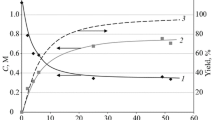Zusammenfassung
Monohalogenierte Methane können mutagen und karzinogen wirken. Die vorliegende Arbeit wurde durchgeführt, um den diesen Winkungen möglicherweise zugrundeliegenden Mechanismus, nämlich die Methrylierung von DNA, zu untersuchen. Hierzu wurden die DNA-Addukte aus Organen von gegenüber14C-markierten Methylnalogeniden exponierten F-344 Ratten mit Hilfe von Hochleistungsflüssigkeitschromatographie (HPLC) und Gaschromatographie gekoppelt mit Massenspek trometrie(GC/MS) getrennt und identifiziert. Folgende Ergebnisse konnten erzielt werden: Die Trennung von enzymatisch nydrolisierten DNA-Proben aus Organen von Ratten, die oral und innalativ gegen14C-Methylbromid und14C-Methyliodid exponiert worden waren, über HPLC und die Bestimmung der Radioaktivitätsverteilung in den Fraktionen ergab neben einem Einbau von14C in die physiologischen Basen die Bildung von DNA-Addukten, nämlich 7-Methylguanin (7-MeG) und O6-Methyldesoxyguanosin (O6-MedG). Die Bildung dieser DNA-Addukte war von Organ zu Organ nur quantitativ unterschiedlich. Die Trennung von entsprechenden sauer hydrolisierten DNA-Proben nach Zusatz von internem Standard (6-MeG) über HPLC konnte Bildung von O6-MeG bestätigen.14C-7-MeG und14C-3-Methyladenin (14C-3-MeA) konnten mit GC/MS Analyse identifiziert werden.
Abstract
Monohalogenated methanes (methyl chloride, methyl bromide and methyl iodide) are mutagenic and carcinogenic. The possible mechanism of these effects, DNA methylation, was studied. DNA adducts from orgnas of F344 rats exposed to these chemicals were separated and identified with high performance liquid chromatography (HPLC) and gaschro-matography/massspectrometry (GC/ MS). DNA adducts, 7-methylguanine (7-MeG) and O6-Methylguanine(08-MeG), incorporation of14C into de novo synthesis of nucleobases could be observed in enzymatic DNA hydrolysates by HPLC and determination of the radioactivity in the fractions. The formation of DNA add,ue,ts in the studied organs was only quantitatively different. The formation of O6-MeG was further pioved by analysing the acidic hydrolysates using HPLC with non-radioactive O6MeG as internal standard. 7-MeG and 3-MeA were identified with GC/MS analysis.
Similar content being viewed by others
Literatur
Andrews A Wet al. A comparison of the mutagenic properties of vinyl and methyl chloride. Mutat Res, 1976;40: 273–276
McCan Jet al. Detection of carcinogens as mutagens in the Salmonella microsome test: Assay of 300 chemicals. Proc Natl Acad Sci, USA, 1975, 72;5135–5139
Simmon V Fet al. Mutagenic activity of chemicals identified in drinking water. In: Scott Det al. Development in Toxicology and Environmental Science, vol 2: Progress in Genetic Toxicology. 1st ed. Amsterdam: Elsevier/ North-Holland Medical Press, 1977; P 249–258
Clive Det al. Validation and characterization of the L5138Y/TK+/mouse lymphoma mutagen assay. Cancer Res, 1983, 43:1945.
Bauelle Columbia Laboratories. Final report on a chronic inhalation toxicology studies in rats and mice exposed to methyl chloride submitted to CII T 1981, vol 1–4.
Danse L H J Cet al. Methyl bromides Carcinogenic effects on the rat forestomach, Toxicol Appl Pharmacol, 1984; 72:261–272
Poirier LAet al. Bioassay of alkyl halides and nucleotide base analogs by pulmonary tumor response in strain A mice. Cancer Res 1975; 35:1411–1415
Bolt H Met al. Disposition of (1, 2-l4C) vinyl chloride in rat. Arch Toxicol, 1976;35:153–162
Rickwood D, Birnie G D. Preparation, characterization and fractionation of chromatin. In: Birnie GD. Subnuelear Components: Preparation and Fractionation. London, Boston: Butterworths, 1976;P129–180
Lawley P D, Brookes P. Acidic dissociation of 7,6-dialkylguanines and possible relation to mutagenic properties. Nature, 1961; 192:1081–1082
Abbott P J, Saffhill R. DNA synthesis with methylated poly(dC-dG) templates: Evidence for a Competitive nature to miscoding by O6-methylguanine. Biochim Biophys Acta, 1974;562:51–53
Goch R, Rajewsky M F. Persistence of O6-methylguanine in rat brain DNA: Correlation with nervous systemspecific carcinogenesis by ethylnitrosourea. Proc Natl Acad Sci, USA, 1974; 71:639–643
Swann P F, Magee P N. Induction of rat kidney tumors by ethyl metnanesulphonace and methyl methanesulphonate. Biochem J, 1969; 11C:39–47
Kornbrust D Jet al. Association of inhaled14C-methyl chloride with macromolecules from various rat tissues. Toxicol Appl Pharmacol, 1982;65: 122–124
Peter Het al. DNA binding assay of methyl chloride. Arch Toxicol, 1985; 57:84–87
Xu D Get al. Hemoglobin adducts of monohalomethanes. Ind Health, 1990, 28:121–123
Author information
Authors and Affiliations
Additional information
Diese Arbeit wurde im Institut für Arbeitsphysiologie an der Universität Dortmund durchgeführt.
Rights and permissions
About this article
Cite this article
Dai-gen, X., Han-zhen, H., Guo-gao, Z. et al. DNA-Methylierung von monohalogenierten Methanen in F-344 Ratten. Journal of Tongji Medical University 13, 100–104 (1993). https://doi.org/10.1007/BF02887924
Received:
Issue Date:
DOI: https://doi.org/10.1007/BF02887924




